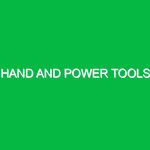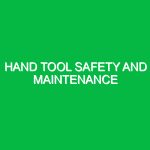In the world of construction, manufacturing, and various trades, power tools are indispensable. However, with great power comes great responsibility. Before embarking on any project involving power tools, it’s crucial to inspect them thoroughly. This practice not only ensures the tools are in good working order but significantly reduces the risk of accidents. This article delves deep into the importance of inspecting power tools before use, the hazards involved, and best practices to prioritize health, safety, and environmental (HSE) standards.
Understanding the Importance of Inspecting Power Tools Before Use
Inspecting power tools before use is a proactive measure aimed at identifying potential issues that could lead to accidents or equipment failure. This process encompasses a visual examination and operational checks to ensure that each tool functions correctly and safely. In HSE terms, it is a preventive strategy that minimizes risk, promotes worker safety, and enhances productivity.
Imagine a scenario in a busy workshop where a worker reaches for a circular saw without a second thought. If that tool hasn’t been inspected, a dull blade or a frayed power cord could result in injury or, worse, a fatality. Such incidents not only have devastating effects on individuals but also on companies, leading to financial losses, legal ramifications, and damage to reputation. Thus, the act of inspecting power tools should be ingrained in the culture of safety within any organization.
Identifying Hazards and Risks Associated with Power Tools
While power tools are designed to enhance productivity, they come with inherent hazards. The potential risks associated with power tools can be categorized into several key areas:
1. Mechanical Hazards
Mechanical hazards are perhaps the most obvious risks associated with power tools. These include moving parts that can cause cuts, lacerations, or crush injuries. For instance, a worker using a table saw without checking safety features could inadvertently come into contact with the blade, resulting in severe injuries. Regular inspections can identify issues such as unguarded blades or malfunctioning safety switches.
2. Electrical Hazards
Electrical hazards pose a significant risk, especially when tools are used in damp or wet conditions. A frayed power cord or a damaged plug can lead to electric shocks or fires. Inspecting power tools for signs of wear and tear in electrical components is crucial. For example, a construction site worker once experienced a near-miss when he plugged in a drill only to find a frayed cord. His quick inspection saved him from a potentially life-threatening situation.
3. Ergonomic Risks
Prolonged use of power tools can lead to repetitive strain injuries. Tools that are not ergonomically designed can cause discomfort and long-term health issues. Inspecting tools for ergonomic features, such as grip and weight distribution, can help mitigate these risks. Workers should be encouraged to report discomfort immediately to prevent chronic injuries.
4. Environmental Hazards
Power tools can also contribute to environmental hazards. For instance, improper disposal of batteries or chemical-laden tools can lead to contamination. Ensuring tools are inspected for environmental compliance is vital. A case study from a construction site revealed that improper disposal of power tool batteries resulted in soil contamination, leading to hefty fines and cleanup costs.
Best Practices and Safety Precautions for Inspecting Power Tools
To effectively mitigate the risks associated with power tools, implementing best practices for inspecting them is essential. Here are several actionable steps to follow:
1. Establish a Routine Inspection Schedule
Creating a structured inspection schedule ensures that power tools are examined regularly. This routine should include daily checks before use, as well as more detailed weekly or monthly inspections. Documenting these inspections can help track any recurring issues or trends.
2. Conduct Visual Inspections
Before using any power tool, perform a thorough visual inspection. Look for signs of wear, damage, or missing parts. For example, check blades for dullness or chips and ensure that guards are in place. A simple visual inspection can catch problems before they escalate into accidents.
3. Test Operational Controls
After the visual inspection, test the tool’s operational controls. Ensure that switches, triggers, and safety features function properly. For instance, a worker once discovered that the safety switch on a miter saw was malfunctioning during a routine check, preventing a potential accident during usage.
4. Inspect Electrical Components
Pay close attention to the electrical components of the tool. Inspect cords for frays and ensure connections are secure. If a tool has been exposed to wet conditions, examine it thoroughly before using it. This step is crucial for preventing electric shock.
5. Provide Training for Workers
Education is key to ensuring safety on the job. Train workers on how to inspect power tools properly and stress the importance of this practice. Encourage them to report any issues immediately, fostering a culture of safety. Anecdotes from experienced tradespeople can be powerful teaching tools. For instance, sharing stories of near-misses due to neglected inspections can resonate with workers and reinforce the importance of diligence.
Regulations and Standards Governing Power Tool Inspections
Compliance with regulations is an essential aspect of inspecting power tools. Various standards govern the safety of power tools and inspections. Among the most notable are:
1. Occupational Safety and Health Administration (OSHA)
OSHA sets forth regulations that require employers to ensure that tools are maintained in a safe condition. This includes regular inspections and maintenance. According to OSHA standards, employers must also provide training on the proper use of tools, which includes how to inspect them.
2. American National Standards Institute (ANSI)
ANSI provides guidelines for the safe design and use of power tools. These standards encompass inspection protocols, ensuring that tools meet safety requirements before they are put to use. Familiarizing oneself with ANSI standards can aid organizations in complying with safety regulations.
3. Manufacturer’s Guidelines
Each power tool comes with manufacturer guidelines that include specific inspection and maintenance requirements. These instructions are tailored to the particular tool and offer valuable insights into how to keep it in optimal working condition. Following these guidelines is paramount for safety and effective tool performance.
Conclusion: Prioritizing Safety Through Inspection
Inspecting power tools before use is not merely a good practice; it is a fundamental necessity for ensuring safety in any work environment. By understanding the potential hazards, implementing effective inspection protocols, and adhering to relevant regulations, organizations can create a safer workplace for their employees. The anecdotes and examples shared in this article illustrate the critical role that thorough inspections play in accident prevention. Remember, a few minutes spent inspecting power tools can save lives and prevent costly accidents. So, before you pick up that drill or saw, take the time to inspect it properly—your safety depends on it.


